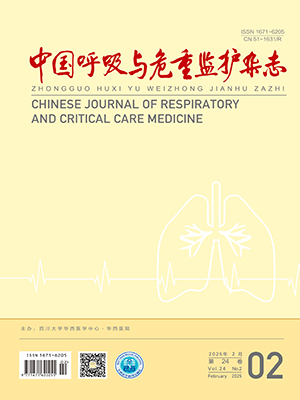| 1. |
钱桂生. 肺癌流行病学与启示. 中国临床医生杂志, 2009, 37(9): 3-4.
|
| 2. |
钱桂生, 余时沧. 肺癌流行病学最新资料与启示. 中华结核和呼吸杂志, 2012, 35(2): 86-89.
|
| 3. |
Le CT, Scagliotti G, Natale R, et al. Efficacy of gemcitabine plus platinum chemotherapy compared with other platinum containing regimens in advanced non-small-cell lung cancer: a meta-analysis of survival outcomes. Lung Cancer (Amsterdam, Netherlands), 2005, 47(1): 69.
|
| 4. |
Herbst RS, Heymach JV, Lippman SM. Molecular origins of cancer: lung cancer. N Engl J Med, 2008, 359(13): 1367-1380.
|
| 5. |
Mok TS, Wu YL, Thongprasert S, et al. Gefitinib or carboplatin-paclitaxel in pulmonary adenocarcinoma. N Engl J Med, 2009, 361(10): 947-957.
|
| 6. |
Kobayashi S, Boggon TJ, Dayaram T, et al. EGFR mutation and resistance of non-small-cell lung cancer to gefitinib. N Engl J Med, 2005, 352(8): 786-792.
|
| 7. |
Pao W, Miller VA, Politi KA, et al. Acquired resistance of lung adenocarcinomas to gefitinib or erlotinib is associated with a second mutation in the EGFR kinase domain. PLoS Med, 2005, 2(3): e73.
|
| 8. |
Bean J, Brennan C, Shih JY, et al. MET amplification occurs with or without T790M mutations in EGFR mutant lung tumors with acquired resistance to gefitinib or erlotinib. Proc Natl Acad Sci U S A, 2007, 104(52): 20932-20937.
|
| 9. |
Turke AB, Zejnullahu K, Wu YL, et al. Preexistence and clonal selection of MET amplification in EGFR mutant NSCLC. Cancer cell, 2010, 17(1): 77-88.
|
| 10. |
Metro G, Chiari R, Duranti S, et al. Impact of specific mutant KRAS on clinical outcome of EGFR-TKI-treated advanced non-small cell lung cancer patients with an EGFR wild type genotype. Lung Cancer, 2012, 78(1): 81-86.
|
| 11. |
Uramoto H, Iwata T, Onitsuka T, et al. Epithelial-mesenchymal transition in EGFR-TKI acquired resistant lung adenocarcinoma. Anticancer Res, 2010, 30(7): 2513-2517.
|
| 12. |
Thiery JP, Acloque H, Huang RY, et al. Epithelial-mesenchymal transitions in development and disease. Cell, 2014, 139(5): 871.
|
| 13. |
Zeng Q, Li W, Lu D, et al. CD146, an epithelial-mesenchymal transition inducer, is associated with triple-negative breast cancer. Proc Natl Acad Sci U S A, 2012, 109(4): 1127-1132.
|
| 14. |
Ye Z, Zhang C, Tu T, et al. Wnt5a uses CD146 as a receptor to regulate cell motility and convergent extension. Nature Commun, 2013, 4(1): 2803.
|
| 15. |
Liang YK, Zeng D, Xiao YS, et al. MCAM/CD146 promotes tamoxifen resistance in breast cancer cells through induction of epithelial-mesenchymal transition, decreased ERα expression and AKT activation. Cancer Letters, 2017, 386: 65-76.
|
| 16. |
Liu WF, Ji S R, Sun J J, et al. CD146 expression correlates with epithelial-mesenchymal transition markers and a poor prognosis in gastric cancer. Int J Mol Sci, 2012, 13(5): 6399-6406.
|
| 17. |
张晓菊, 安云霞, 汪铮, 等. 上皮间质转化及 CD146 和 N-cadherin 在判定肺腺癌 EGFR-TKI 获得性耐药中的作用. 中华实用诊断与治疗杂志, 2014, 28(9): 849-851.
|
| 18. |
Johnson JP, Rothbächer U, Sers C. The progression associated antigen MUC18: a unique member of the immunoglobulin supergene family. Melanoma Res, 1993, 3(5): 337-340.
|
| 19. |
Shih IM. The role of CD146 (Mel-CAM) in biology and pathology. J Pathol, 1999, 189(1): 4-11.
|
| 20. |
Yan X, Lin Y, Yang D, et al. A novel anti-CD146 monoclonal antibody, AA98, inhibits angiogenesis and tumor growth. Blood, 2003, 102(1): 184-191.
|
| 21. |
Wu GJ, Varma VA, Wu MWH, et al. Expression of a human cell adhesion molecule, MUC18, in prostate cancer cell lines and tissues. Prostate, 2001, 48(4): 305-315.
|
| 22. |
樊静, 任红, 张芳, 等. 肺癌组织 CD105 和 CD146 表达及其临床意义的研究. 中华肿瘤防治杂志, 2011, 18(21): 1685-1687.
|
| 23. |
Dogan I, Karyagar S, Karyagar SS, et al. Relationship between pretreatment levels of serum Cyfra 21.1, CEA and PET metabolic parameters in NSCLC. Ann Nucl Med, 2014, 28(9): 829-835.
|
| 24. |
Rudin CM, Durinck S, Stawiski EW, et al. Comprehensive genomic analysis identifies SOX2 as a frequently amplified gene in small-cell lung cancer. Nat Genet, 2012, 44(10): 1111.
|
| 25. |
Yu HA, Arcila ME, Rekhtman N, et al. Analysis of tumor specimens at the time of acquired resistance to EGFR-TKI therapy in 155 patients with EGFR-mutant lung cancers. Clin Cancer Res, 2013, 19(8): 2240-2247.
|
| 26. |
Watanabe S, Sone T, Matsui T, et al. Transformation to small-cell lung cancer following treatment with EGFR tyrosine kinase inhibitors in a patient with lung adenocarcinoma. Lung Cancer, 2013, 82(2): 370-372.
|




